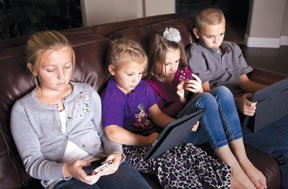| << Back |
Family Ties: Off the Grid – Keeping Family Screen Time to a Minimum
By Jennifer Vandenberg
With today’s endless proliferation of TV, video games and internet, there is no shortage of reasons for today’s kids to become couch potatoes. The American Academy of Pediatrics has linked excessive “screen time” to obesity, attention problems, trouble with sleep, impaired academic performance and more. Per their recommendations, children over the age of two should have “no more than one or two hours” of screen time per day.
Of course, things can get out of hand during the summer, when it’s often too hot to play outside and there aren’t many options to keep the young ones occupied. The good news is that weekend and summer screen time have not been associated with lower school performance in the way that weekday screen time has. But as school starts up once again, every day is no longer a vacation, so it’s a perfect time to consider family media use.
As with anything else, it’s good to set a plan from the beginning, which should make it easier to monitor your screen based entertainment time. Below you’ll find suggestions on setting goals and drawing boundaries to help make things easier on the whole family.
Chart Your Time
Start out by spending a few days charting media use for each family member. Everything counts: the morning news that nobody is really watching, the YouTube clip your teenager needs to view for homework, the ballgame that is on in the background at dinner time, video games and the time spent texting or posting on any kind of social media sites.
Use this charted data to help create a media plan. Set a limit on TV time and encourage your child to choose only their favorite shows to watch and favorite video games to play. Schedule “black out” hours when screen time is not acceptable, such as dinner or family gatherings. The DVR can be one of your best friends in this situation. Record shows your kids want to watch and skip through the commercials. This can cut TV time by a third!
You can even have kids use timers to help limit themselves; giving them some control should help make them more eager to participate. Make sure the media plan takes into account the time they spend at friends’ houses as there’s no sense setting a plan if the kids are going to “cheat” by spending unlimited amounts of screen time somewhere else.
Out of Sight, Out of Mind
Often times, the media distractions available to our kids are taken advantage of just because they are there. By finding ways to limit the presence of electronic media, you should be able to keep a better hold on limiting screen time. Consider these suggestions:
- Move the computer to the family room. Not only does this allow you to keep better tabs on internet use, but teachers also recommend that homework is best done in a communal area so parents can provide help and curtail time wasting.
- Cell phones should be kept out the bedroom at night. Your teen is not likely to get a restful sleep if they lie awake texting with friends until three in the morning.
- Remove the TV from your child’s room. This can be tough to handle, especially if they’re used to having one, so you can start by removing it only on weekdays.
- Establish “bedtime” for screens in addition to bedtime for the kids, preferably not too close to each other so that kids can settle down from media over-stimulation.
Lead By Example
No matter what suggestions you decide to follow for your kids, make sure you are keeping up your end of the bargain by monitoring and restricting your own screen time. Consider removing the TV from your own bedroom, canceling cable or eliminating “background” television like morning programs or afternoon talk shows. If you’re a sports fan, think about subscribing to nfl.com and/or mlb.com to follow your teams via internet radio broadcasts instead of ESPN. As a bonus, you’ll save hundreds of dollars.
Limiting screen time is not about deeming television sets and computers as evil but more about finding the balance between media and other activities. By setting the right boundaries and getting everyone in the family to participate, it can be a useful activity that encourages more communal bonding and improves everyone’s all around well being.








